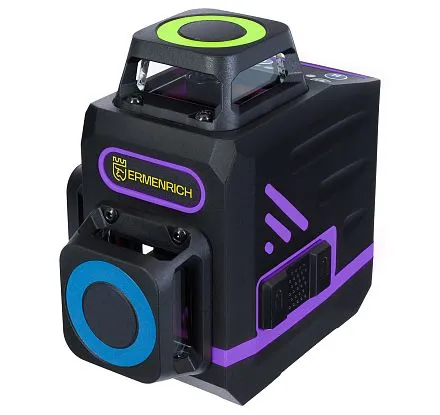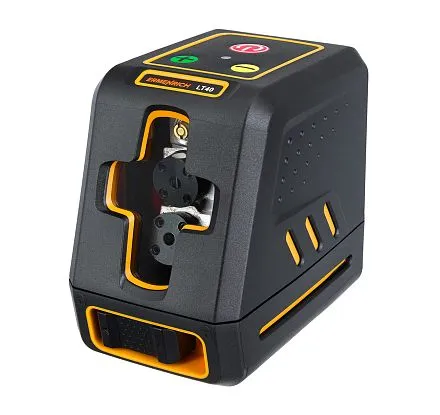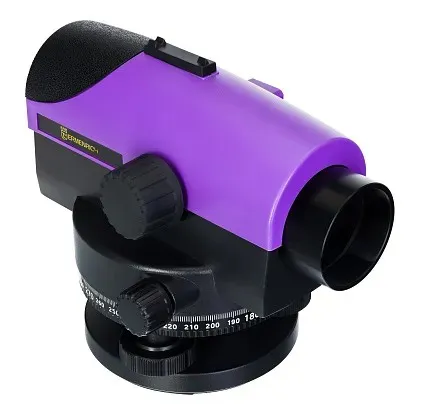What is a level used for
An optical level is a device used to perform geodetic and construction measurements. It is designed to determine height differences on the ground and accurately align objects relative to the horizontal plane. This tool is widely used in the construction of buildings, roads, bridges, and other engineering structures.
Operating principle.
Let’s start with how an optical level works. The main elements of this instrument include a tribrach, a metal disk mounted on three supports. It has three lifting screws for securing and adjusting the position of the main unit. The main block consists of the following components:
- a telescope (optical part) with an eyepiece and a sight;
- horizontal circle;
- eyepiece focusing knob;
- horizontal drive and leveling screws;
- bubble levels;
- compensator, which is an air or magnetic damper that reduces vibrations and prevents error increase.
Measurements are taken using the telescope with magnifying lenses. Maximum image clarity is achieved using adjustment knobs. Deviations are recorded vertically and horizontally on a scale. This device can be used to determine the height of objects, the difference in height between points, or to measure tilt angles.
What to look for when choosing an optical level.
If you want to build a house, an optical level will become an indispensable tool in your arsenal. When buying a device, it is important to consider certain characteristics and details to make the right choice.
Focal length.
This parameter determines how clearly an object can be seen without blurring. Focal length has a significant impact on the viewing angle: As this distance decreases, the viewing angle increases. Levels have a focal length of 20cm to 1m. For everyday tasks, this parameter is not so critical and can be ignored. However, in large construction projects, this value becomes significant. Ultimately, shorter focal lengths usually produce better results.
Methods of setting the sighting line.
The sighting line is a straight line that matches the optical axis of the device. There are two types of levels depending on the method of installing the sighting line:
- With a level. In this case, the sighting line is automatically aligned with the cylindrical level.
- With a compensator. Here, the compensator sets the sighting line without human intervention, which guarantees more accurate results compared to manual setting.
Magnification.
The instrument’s telescope magnification determines the observation range. The minimum magnification of optical levels is 20x, while the maximum is 38x. If you are working in a small area, choose a device with a magnification of 20x to 24x, as it will be more affordable than models with higher magnification. For specialists working in large areas, devices with a magnification of 34x and higher are recommended. The most common instruments on the market have 24x and 32x magnifications.
Accuracy.
On this point, levels split into three categories:
- Class I levels are the most accurate devices with an error of less than 0.3mm per 1km. They are designed for work where even the smallest error can be critical. These levels use a telescope that can obtain both direct and reverse images. Some devices are additionally equipped with plates with micrometer markings.
- Class II levels are high-precision devices with an error of up to 3 mm per 1 km. Their telescope produces only an upright image. These levels are ideal for building construction and road work.
- Class III levels (technical) have an error of up to 10mm per 1km. Despite the relatively large error, they are often used in small projects and construction work. These instruments must be equipped with a level or compensator. The higher the accuracy of the level, the higher its price, and so you should carefully consider the need to purchase a high-precision device.
What other factors should you consider when purchasing an optical level?
Modern models have many additional functions that increase their service life and make them easier to use:
- Dust and moisture protection. To avoid damage to the device when used outdoors, choose levels with an IP54 or IP56 protection level.
- Additional prism. The presence of a prism allows you to obtain a “direct” image when magnified rather than a “reverse” one. It is important to ensure that the image clarity is not lost.
- Compensators with magnetic or air damping. They are designed to align the line of sight horizontally in the range of ±15-20'.
Let us tell you what a level is for and how it is used.
What is an optical level used for?
Optical levels are based on a system that allows the operator to observe the sighting line and take precise measurements on the ground. The main element of the level is a telescope mounted on a stable platform. It is equipped with a lens system and a prism that directs the image of the object to the eyepiece.
What optical levels are used for:
- The main task of the instrument is to determine the difference in heights between points on the ground relative to the baseline for construction and area planning.
- Aligning objects on a horizontal plane. This is necessary when constructing foundations, laying road surfaces, and other construction tasks.
- The device is used to create and test a leveling network, which is used to tie objects to a common coordinate and height system.
- The tool is also used to transfer elevation marks from one point to another to align structures during the construction of buildings, roads, and other objects.
Optical levels have high accuracy, which makes them suitable for use in tasks where minimal measurement error is required. Accuracy depends on the quality of the optical systems that are used, and so your device choice must take into account the specifics of the required tasks.
What optical levels are used for
What is an optical level used for and in what areas:
- Construction of buildings and structures. Why is an optical level needed in construction? It can be used to accurately align building foundations, determine the height of walls, and control horizontal planes when laying concrete or other building materials.
- Why are optical levels needed in road construction? When laying the surface and constructing roads, it is extremely important to adhere to precise values for the height and surface slope. An optical level is used to monitor the slope of a road surface as well as to determine the height of an embankment or excavation.
- In engineering projects involving the construction of bridges, dams, tunnels, and other complex objects, using an optical level ensures accuracy at all stages of construction.
- The devices are used to determine elevation marks on the ground when planning construction sites, preparing land for agriculture, or developing park areas. With their help, you can accurately calculate the required amount of soil to move in order to level the area or create a relief.
- When constructing canals, dams, and other hydraulic objects, an optical level allows you to maintain the exact level of structures, which is necessary to ensure the correct distribution of water.
- The device is used to monitor compliance with the standards and regulations in construction and surveying. It can be used to take precise measurements on objects and to check the compliance of built structures with design values.
- How is an optical level used in surveying? It is used to analyze the sedimentary processes associated with changes in the height of soils or building structures.
An optical level is an indispensable tool for performing precise height measurements and aligning objects. Its use ensures high accuracy in complex projects related to site planning, road and building construction as well as monitoring compliance with the standards at sites.













